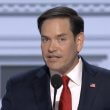The UN nuclear watchdog said Monday that it estimated Iran’s stockpile of enriched uranium had grown to more than 18 times the limit laid down in Tehran’s 2015 deal with world powers.
The International Atomic Energy Agency said in its latest report on Iran’s nuclear program that it “estimated that, as of May 15, 2022, Iran’s total enriched stockpile was 3,809.3 kilograms.”
The limit in the 2015 deal was set at 300 kilograms (660 pounds) of a specific compound, the equivalent of 202.8 kilograms of uranium. The report also said that Iran is continuing its enrichment of uranium to levels higher than the 3.67 percent limit in the deal.
The stockpile of uranium enriched up to 20% is now estimated to be 238.4 kilograms, up 56.3 kilograms since the last report in March, while the amount enriched to 60% stands at 43.1 kilograms, an increase of 9.9 kilograms.
Enrichment levels of around 90% are required for use in a nuclear weapon.
Earlier in May, the IAEA announced that it was “extremely concerned” by Iranian silence on potential undeclared nuclear sites.
“I am referring to the fact that we, in the last few months, were able to identify traces of enriched uranium in places that had never been declared by Iran as places where any activity was taking place,” IAEA head Rafael Grossi told a European Parliament Committee.
“The situation does not look very good. Iran, for the time being, has not been forthcoming in the kind of information we need from them… We are extremely concerned about this,” Grossi said.
Iran has always insisted that its nuclear program is peaceful. Israel views a nuclear-threshold Iran as an unacceptable threat, as Tehran is avowedly committed to the destruction of the Jewish state.
Both American and Israeli officials have assessed that Iran now needs only a few weeks to amass enough fissile material for a bomb, should it choose to make one, though it would need additional time to assemble the device’s other components.
“[Iran] stands just a few weeks away from accumulating fissile material that will be sufficient for a first bomb, holds 60 kilograms of enriched material at 60%, produces metallic uranium at the enrichment level of 20%, and prevents the IAEA from accessing its facilities,” Defense Minister Benny Gantz said on May 17.
Officials in the current US administration, led by President Joe Biden, blame the drop in Iran’s breakout time on former president Donald Trump’s decision to withdraw from the nuclear agreement in 2018.
“Their breakout period is down from about a year, which is what we knew it was during the deal, to just a few weeks or less,” White House Press Secretary Jen Psaki said at a press conference in February.
The latest report comes as talks to revive the landmark 2015 nuclear deal between Iran and world powers remain deadlocked after stalling in March.










